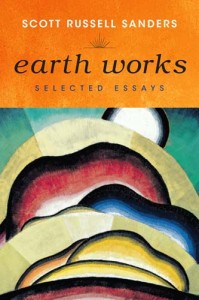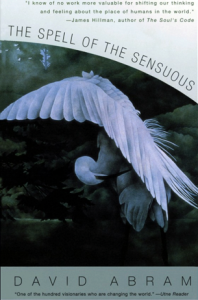“If we surrendered to earth’s intelligence we could rise up rooted, like trees.”
― Rainer Maria Rilke
Last year I took a graduate course in ecopoetics, the insights from which have incrementally blown my mind. In the course I read Spell of the Sensuous: Perceptions and Language in a More-Than-Human World by David Abram, which introduced me to the cognitive connection between humans and the animate world. Abram challenged how I understood my relationship to nature and the craft of nature writing. He made me question what truth I could possibly write toward in my experiences with the natural world, while still divorcing my identity from that place. As much as I loved my time in the woods, I’d come to see myself as other—a voyeur, an outsider.

I’m not alone. There’s a palatable urgency to write the story of human/nonhuman relationships. Terms such as “mass extinction” and “desertification” have left the confines of scientific scholarship and found their way into news headlines. No wonder that the  literary community has taken notice and opened the floor for discussions that go beyond what environmental writing has traditionally offered. The 2014 AWP conference will host a multitude of nature writing panels, but panel titles such as “Writing about Nature in an Unnatural World” suggest a new emphasis in the study of environmental writing. Next summer’s Chautauqua Writers’ Festival will feature faculty such as Barbara Hurd and Scott Russell Sanders, both accomplished and celebrated nature writers whose work diverges from traditional conventions into the more spiritual, sensorial terrain of human/nonhuman kinship. Hurd, winner of Sierra Club’s National Nature Writing Award, is the author of Stirring the Mud: On Swamps, Bogs, and Human Imagination, a meditation of sorts on how human creativity shares a landscape and place in time with natural wetlands. Scott Russell Sanders, another NEA fellow, recently published Earth Works: Selected Essays, which explores the elements in our lives that disrupt our connections to place.
literary community has taken notice and opened the floor for discussions that go beyond what environmental writing has traditionally offered. The 2014 AWP conference will host a multitude of nature writing panels, but panel titles such as “Writing about Nature in an Unnatural World” suggest a new emphasis in the study of environmental writing. Next summer’s Chautauqua Writers’ Festival will feature faculty such as Barbara Hurd and Scott Russell Sanders, both accomplished and celebrated nature writers whose work diverges from traditional conventions into the more spiritual, sensorial terrain of human/nonhuman kinship. Hurd, winner of Sierra Club’s National Nature Writing Award, is the author of Stirring the Mud: On Swamps, Bogs, and Human Imagination, a meditation of sorts on how human creativity shares a landscape and place in time with natural wetlands. Scott Russell Sanders, another NEA fellow, recently published Earth Works: Selected Essays, which explores the elements in our lives that disrupt our connections to place.

This year the Willa Award for Creative Nonfiction went to Priscilla Stuckey for her collection of essays, Kissed by a Fox: And Other Stories of Friendship in Nature. The stories revolve around themes of interconnectedness—and ways in which to find interconnectedness—between humans and nature. Another essay collection, The Small Heart of Things by Julian Hoffman, explores how feelings of foreignness and isolation are matters of perception that can be altered with the acknowledgment that our existence is just as vital to the environment as the environment is to us. Stuckey, Hoffman, and a growing number of writers like them examine that which is the beating pulse of nature writing, communion with wildness and wilderness, but find that communion and conservation aren’t enough to save us from the self-destruction we’re barreling toward, as we exploit dwindling resources. In fact, the growing sentiment in nonfiction nature writing seems to suggest we forget whole notion of “being human,” that we should just shake off any language that creates distinctions from one species and another. “Quit acting like an animal” seems an innocuous phrase, but it reinforces the idea that we are something other than animal. To say the Everglades are in trouble or the Florida panther is endangered are half-truths because such statements leave us humans out of the equation. We forget that what happens to the swamp and the wild cat happens to us.

The emerging popularity of nature writing that shifts its focus from a walk in the woods to a conversation with the woods, so to speak, has not gone unnoticed. The Better World Book Club featured on Good Reads devotes their community reading and discussion to this nature genre within nonfiction. MFA programs around the country are adapting concentrations in environmental writing: Iowa State University’s Creative Writing and Environment program and Chatham University’s concentration in nature writing, to name a few.
There appears to be a growing recognition of creative nonfiction as an ideal genre from which to launch the exploration into human/nonhuman relationships. Environmental writing has been primarily rooted in the study of our biology in place and our impact upon it, but the critical story of our inextricable connection with the natural world has gone largely untold. Creative nonfiction allows for the story of us in the world to develop the narrative arc of subjectivity and self-reflexivity in a way that objective reporting and ethnography can’t afford.
by Colorado Review Editorial Assistant, Whitney Dean
Whitney Dean is a creative nonfiction graduate student and composition instructor at Colorado State University. She writes about her Florida roots, drug addiction, and suffering animals.
